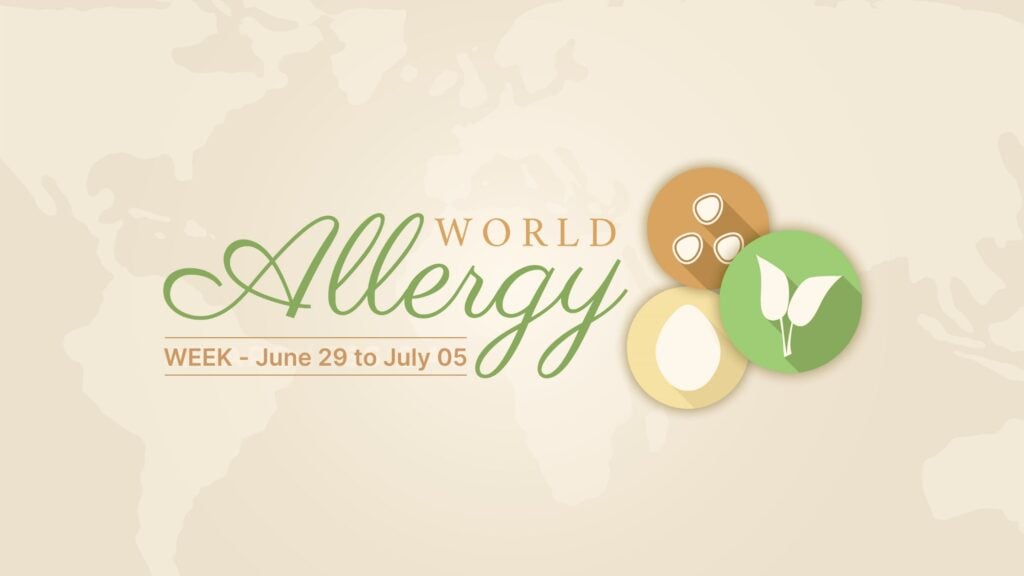World Arthritis Day 2025: Raise Awareness for Arthritis Health & Care
Welcome! As World Arthritis Day 2025 approaches, let’s raise awareness about arthriti...
SCAB Pharmacy

Allergies are incredibly common, affecting millions worldwide. Understanding what allergies are, how your immune system reacts to various substances, and the common types of allergens can empower you to better manage and prevent allergic reactions. This article will delve into the core aspects of allergies, from their underlying mechanisms to prevalent types and effective management strategies.
An allergy is a chronic condition where your body’s immune system mistakenly perceives a normally harmless substance as a threat, leading to an overreactive response. This hypersensitivity can cause a range of symptoms, making allergies one of the most common chronic diseases, particularly in children. When you come into contact with something you are allergic to, whether by touch, inhalation, or ingestion, your body initiates a defense mechanism to try and eliminate what it perceives as harmful.
When an individual experiences an allergy, their immune system produces a specific antibody called immunoglobulin E (IgE) in response to allergens. This IgE acts as a tag, alerting the immune system to substances it considers dangerous. Upon subsequent exposure to the same allergen, these antibodies activate mast cells, which are critical watchdogs residing in your skin, nose, eyes, and digestive system. These mast cells then release potent chemicals like histamines, cytokines, and leukotrienes, which are the primary culprits behind the various allergy symptoms, including those related to sinusitis.
Many types of allergies exist, each triggered by specific allergens. Common categories include drug allergies, often caused by penicillin or sulfonamide antibiotics, and food allergies, frequently involving milk, eggs, peanuts, or shellfish. Environmental allergens like pollen can cause seasonal allergies and hay fever, while pet dander from dogs or cats can trigger animal allergies. Furthermore, contact dermatitis can result from substances such as latex or poison ivy, and household pests like dust mites and mold are common causes of perennial allergic reactions.
The most common allergy symptoms can simply make you uncomfortable, such as watery eyes, a runny nose, and persistent sneezing. Allergies can cause a variety of symptoms including itching, rashes, and swelling, which may be exacerbated by hay fever. Symptoms often depend on how you’re exposed to an allergen, which can vary between adults and children. If you touch something you’re allergic to, you might get an itchy rash or hives. If you’re allergic to pollen or pet dander, you usually get a runny nose or sneeze when you breathe them in. Skin allergy symptoms include redness, bumps, flaky skin, and cracked skin, while animal allergies often cause a stuffy nose and wheezing. Dust allergy symptoms frequently involve sneezing, itchy eyes, and shortness of breath.
More serious allergy symptoms, like trouble breathing and swelling in your mouth or throat, may indicate a life-threatening reaction called anaphylaxis. Food and drug allergies, as well as bee stings, are more likely to cause severe reactions, such as airway swelling and vomiting. Anaphylaxis is a severe allergic reaction that can be life-threatening and requires immediate medical attention. Moderate allergic reactions include symptoms that spread to other parts of your body, such as widespread itching, swelling, or hives, difficulty breathing, tightness in your throat, or a hoarse voice. It’s possible to develop a severe allergic reaction to something you only had a mild reaction to before.
Anaphylaxis is a life-threatening allergic reaction that is sudden and usually involves more than one part of your body. It is more likely with food, drug, or bug sting allergies. Serious symptoms of anaphylaxis include skin rashes, intense itching, or widespread hives. Swelling of the mouth, throat, and tongue can make it hard to breathe or swallow. Other signs include shortness of breath, trouble breathing, wheezing, stomach pain, bloating, vomiting, or diarrhea. Mental confusion, dizziness, or fainting are also critical symptoms, often accompanied by a feeling that something awful is about to happen, signaling an emergency.
The substances that cause allergic reactions are known as allergens. These common triggers in the environment include pollen, dust mites, mold spores, and pet dander. Food, insect stings, and certain medicines can also act as allergens. Spring allergies are frequently caused by tree pollen, while summer allergies are often attributed to grass pollen. Fall allergies are typically triggered by ragweed pollen, which grows extensively across the U.S., particularly in the Midwest and on the East Coast. Exposure to these environmental factors can initiate the immune system’s allergic response, leading to characteristic symptoms.
Both genes and environmental factors likely play a significant role in the development of allergies. You are more likely to have allergies if you have a biological parent with allergies, indicating a genetic predisposition. Furthermore, if anyone in your immediate family has a history of asthma, allergies, or eczema, your likelihood of developing these conditions may increase. This familial link suggests that inherited traits can make an individual’s immune system more prone to developing hypersensitivity to common allergens, leading to an allergic reaction upon exposure. Understanding this genetic component is crucial for prevention and early management of symptoms and causes.
Allergies occur when your immune system mistakenly identifies foreign proteins—found in pollen, pet dander, medications, food, or other substances—as something harmful, similar to a virus or bacteria. Inhaling, eating, or touching something you’re allergic to activates mechanisms designed to protect you and flush the allergen out of your system, causing various symptoms. You generally need to be exposed to a substance more than once before you’ll react to it; the first exposure often sensitizes your body by creating specific antibodies. You may also be more likely to develop a new allergy if you are exposed to an allergen right after you’ve been sick or during pregnancy, as the immune system can be more reactive.
To accurately diagnose allergies, doctors primarily rely on specific allergy testing methods, including skin tests and blood tests. The skin test is widely considered the most common and effective way to identify allergens due to its rapid and precise results. During a skin prick test, a healthcare provider places a tiny drop of a suspected allergen on your skin, then pricks or scratches the surface through the drop, allowing the allergen to penetrate slightly. If the area swells, itches, or turns red, resembling a mosquito bite, it signifies a sensitivity to that allergen, with results typically appearing within 15 minutes. For certain cases, such as when a skin prick test is negative or if a drug or bug venom allergy is suspected, an intradermal skin test might be used, involving a small needle to place the allergen under the skin’s top layers.
In situations where skin tests are not feasible—for instance, if you are taking medications that could interfere with the results, have sensitive skin, or have experienced a severe allergic reaction to a prior skin test—your doctor may opt for a blood test. This method involves sending a blood sample to a laboratory. The lab then introduces various allergens to your blood sample and measures the amount of specific antibodies, particularly immunoglobulin E (IgE), your blood produces against each allergen. This helps the medical team to identify the particular allergens that cause an allergic response in your immune system, aiding in effective allergy treatment planning and the development of a strategy to reduce exposure to the offending substances.
The diagnostic process for allergies typically involves three crucial steps: a thorough review of your personal and medical history, a physical examination, and specific tests to identify your allergens. To pinpoint which allergens to test for, your doctor will inquire about your allergy symptoms and any potential allergens you might be exposed to through your daily life, work, or hobbies. This comprehensive discussion helps to narrow down the possible triggers of your allergic reactions. Understanding your exposure history is a key component in devising an effective allergy diagnosis and subsequent treatment plan.
It is particularly important to consult an allergist if your allergy symptoms do not improve with over-the-counter medications or if you suspect you might have a food allergy. An allergist specializes in diagnosing and managing allergic conditions, providing expert guidance on understanding your specific allergy type and its underlying causes. They can help identify the exact substances that cause allergy symptoms, which is crucial for developing a personalized strategy to manage and prevent future allergic reactions, ensuring you receive the most effective allergy relief.
Interpreting the results of allergy tests is straightforward for skin prick tests: if a tested area swells, itches, or becomes red, similar to a mosquito bite, it signifies that you are sensitive to that specific allergen. Any swelling from such a reaction typically resolves within 30 minutes to a few hours. While blood tests are an alternative, they are generally more expensive and less accurate than skin tests for most allergens. Therefore, skin tests are often preferred for their speed and precision in identifying the cause of allergy symptoms.
For suspected food allergies, if your doctor believes a certain food is the cause of your allergy symptoms, they might recommend an elimination diet. This involves temporarily removing the suspected food from your diet to observe if your symptoms improve, helping to identify the specific food allergen. However, an oral food challenge, which involves consuming small, increasing amounts of a suspected food allergen under medical supervision, should only be performed in a medical office setting by a qualified allergist. This ensures that any severe allergic reactions, such as anaphylaxis, can be promptly and safely managed by a healthcare professional.
Effective allergy treatment is always tailored to your individual medical history and the severity of your allergy symptoms. A comprehensive treatment plan can include avoiding allergens, various medication options, and/or allergy immunotherapy (allergy shots).
| Treatment Type | Description/Examples |
| Avoidance of known allergens is essential to prevent symptoms and causes of allergic reactions. | Staying away from substances that trigger allergic reactions can help prevent severe allergies. |
| Medication Options | Antihistamines, steroid nasal sprays, leukotriene modifiers, omalizumab injections, emergency epinephrine auto-injectors. These medications help reduce the immune system’s response to allergens, providing relief from allergic reactions. |
| Allergy Immunotherapy | Also known as allergy shots. |
Allergy medications work in various ways to alleviate symptoms. Antihistamines, available in pills, liquids, nasal sprays, or eye drops, block histamine to reduce redness, swelling, and itching associated with urticaria. Steroids, effective in reducing inflammation and redness, come as pills, liquids, inhalers, nasal sprays, creams, and eye drops. Decongestants, available as nose sprays, eye drops, liquids, and pills, relieve stuffy noses by shrinking swollen nasal tissues. Leukotriene modifiers treat asthma and nasal allergy symptoms by blocking the effects of leukotrienes.
| Medication Type | Primary Action |
|---|---|
| Biologics | Target specific immune system reactions that cause symptoms in both adults and children. |
| Emergency Epinephrine | Manages severe allergic reactions (anaphylaxis) |
The most effective way to prevent an allergic reaction is to rigorously avoid your known allergens. Developing and adhering to a personalized allergy action plan is crucial for managing your condition effectively. If you continue to experience bothersome allergy symptoms despite medical treatment, certain lifestyle adjustments can offer additional relief. For nasal symptoms, oral decongestants or saline rinses can help alleviate congestion and clear nasal passages. These simple measures can significantly reduce the impact of environmental allergens.
For itchy eyes, applying a cold washcloth or using eye drops specifically formulated for allergies can provide soothing relief. After outdoor activities or exposure to allergens, showering and changing into fresh clothes can help remove lingering allergens from your body and hair, preventing further contact and reducing the likelihood of a continued allergic response. For itchy rashes, hypoallergenic or fragrance-free lotions can help calm and soothe irritated skin, offering a natural way to manage skin allergy symptoms without aggravating sensitive skin. These practical tips are key to a holistic allergy management approach.
Incorporating simple home remedies can provide additional relief for common allergy symptoms and support your overall allergy prevention strategy. A saltwater solution, or saline, can be used as a nasal spray to effectively rinse out sinuses and nasal passages, alleviating symptoms of sinusitis. This helps to relieve mild congestion, loosen bothersome mucus, and prevent crusting, offering a natural way to alleviate nasal allergy symptoms. Neti pots, used with diluted salt water, are also excellent for flushing out mucus and moistening sinus tissues, promoting clearer breathing and reducing inflammation.
For individuals experiencing itchy, dry, watery, or red eyes due to allergies, artificial tears can be a simple yet effective remedy. These eye drops help to lubricate the eyes and wash away irritating allergens, providing immediate comfort. Beyond remedies, preventive measures are paramount. Regularly cleaning your home to reduce dust mites, using allergen-proof bedding, and monitoring pollen counts can significantly reduce your exposure to common environmental allergens that cause symptoms. These proactive steps, combined with appropriate medical treatment, offer the best way to manage and reduce the frequency and severity of allergic reactions.
The best way to prevent an allergic reaction is to avoid your specific allergens. If you have an allergy that could cause a severe reaction, your healthcare provider will likely recommend that you carry an epinephrine auto-injector to use at the first signs of a severe allergic reaction. To effectively avoid reactions to known allergens, you can take practical steps such as avoiding direct contact with animals you’re allergic to, including touching or getting licked by them, and changing your clothes after you’ve been around them to remove any lingering dander. Regularly vacuuming rugs, carpets, and other surfaces in your home is crucial to help remove dust, animal dander, pollen, and other common allergens that can trigger allergic symptoms. Utilizing high-efficiency particulate (HEPA) air filters can significantly help remove allergens from the air around you, improving indoor air quality. During pollen season, it’s advisable to keep your windows closed to prevent pollen from entering your home, and remember to change the filters on your HVAC system according to their recommended schedule to maintain optimal air filtration and reduce allergen exposure.
It is important to talk to a healthcare provider if you consistently experience symptoms of allergies and wish to determine the underlying cause and receive proper allergy diagnosis. Prompt medical attention is vital if you experience signs of a severe allergic reaction, such as swelling of your face, lips, tongue, or throat; difficulty breathing; chest pain or tightness; hives all over your body; tingling in your hands, feet, or lips; feeling weak, dizzy, or faint; or a feeling of dread or impending doom. These serious allergy symptoms indicate an emergency, especially in cases of severe allergies. If you are experiencing a severe allergic reaction, known as anaphylaxis, you need emergency medical help immediately. If you have been prescribed an epinephrine auto-injector pen, administer the shot right away and then call 911. Even if the epinephrine helps you feel better and provides some relief from the allergic symptoms, it is crucial to seek immediate medical attention from a doctor as severe allergic reactions can have a delayed second phase that requires professional observation and treatment.
If you have a history of a serious allergy attack or any past symptoms of anaphylaxis, it is highly recommended to make an appointment with your doctor for long-term help in managing your condition, which should include a prescription for an epinephrine auto-injector. You may also benefit greatly from seeing an allergist or immunologist, specialists who can provide comprehensive care and develop a personalized treatment plan for your specific types of allergies. It is essential to keep your prescribed allergy medication with you at all times so you can treat an allergic reaction promptly. Having an emergency action plan in place is crucial in case you experience a severe allergic reaction, ensuring that you and those around you know exactly what steps to take. If you have a prescription for emergency epinephrine shots and believe you are having an allergic reaction, it is imperative to use your shot immediately. Timely administration of epinephrine can be life-saving and is the most effective way to counteract the severe effects of anaphylaxis, offering the best chance for a positive outcome.

World Allergy Week 2025, observed from 29 June to 5 July, is a global initiative aimed at raising awareness about allergies and their impact on health and quality of life. This annual event brings together healthcare professionals, patients, and organizations to promote better understanding, prevention, and management of allergic diseases. The week focuses on educating the public about common allergens, symptoms, and effective treatments, while encouraging early diagnosis and proper care. In 2025, the campaign emphasizes the importance of reducing exposure to allergens and improving access to allergy services worldwide, helping millions of people live healthier, allergy-free lives.
Understanding and managing allergies is crucial for improving quality of life and preventing severe health outcomes. This comprehensive guide has covered a range of important topics related to allergies, as detailed below:
| Topic | Details Covered |
| Allergy Fundamentals | What allergies are, how the immune system reacts to allergens, common types of allergies, and their typical causes (environmental and genetic factors) can lead to severe allergies. |
| Symptoms & Reactions | Usual symptoms and severe reactions requiring urgent care. |
| Diagnosis | How allergies are diagnosed through various testing methods. |
| Treatment | Available treatment options, including medications and lifestyle adjustments. |
Welcome! As World Arthritis Day 2025 approaches, let’s raise awareness about arthriti...
SCAB Pharmacy

Every October, the world turns pink to raise awareness about breast cancer, a disease that ...
SCAB Pharmacy

Join us in celebrating World Pharmacists Day 2025 and the contributions of pharmacists in t...
SCAB Pharmacy

Do you have any questions? Do not hesitate to contact us.